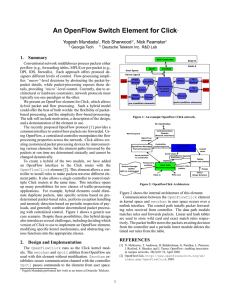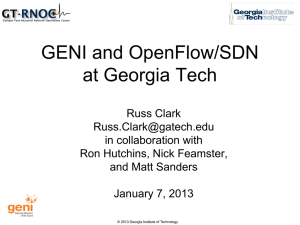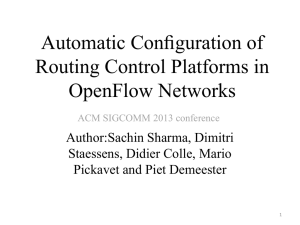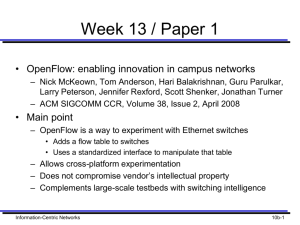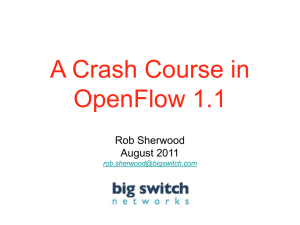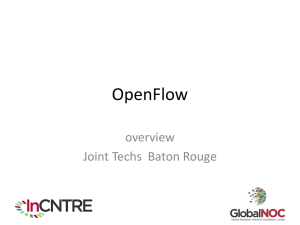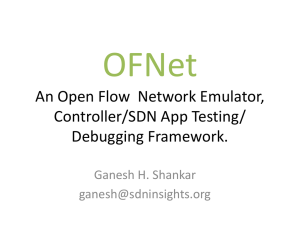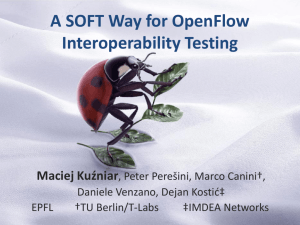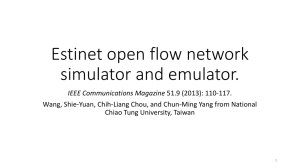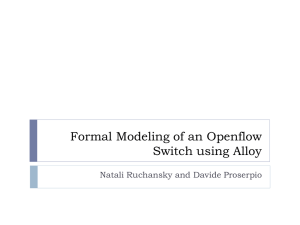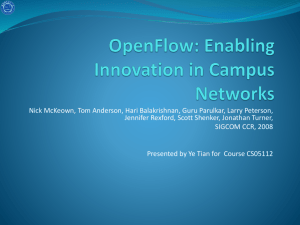OpenFlow in Campus Networks: Enabling Innovation
advertisement
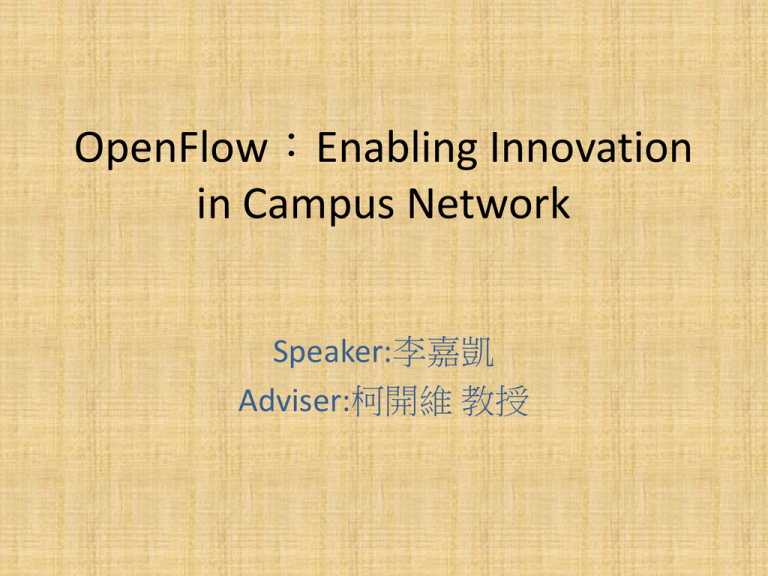
OpenFlow:Enabling Innovation in Campus Network Speaker:李嘉凱 Adviser:柯開維 教授 Outline • • • • • • Introduction The Need For Programmable Network The OpenFlow Switch Using OpenFlow Conclusion Reference Introduction • It is based on an Ethernet switch, with an internal flow-table, and a standardized interface to add and remove flow entries. • OpenFlow could serve as a useful campus component in proposed large-scale testbeds like GENI. The Need For Programmable Network • Today, there is almost no practical way to experiment with new network protocols in sufficiently realistic setting to gain the confidence needed for their widespread deployment. • These programmable networks call for programmable switches and routers that can process packets for multiple isolated experimental networks simultaneously. • Virtualized programmable networks could lower the barrier to entry for new ideas, increasing the rate of innovation in the network infrastructure. OpenFlow is a specification that is an initial attempt to meet the goal high-performance and low-cost implementations. Capable of supporting a broad range of research. Assured to isolate experimental traffic from production traffic. Consistent with vendors’ need for closed platforms. The OpenFlow Switch Consist of at least three parts: 1. A Flow Table 2. A Secure Channel 3. The OpenFlow Protocol Each flow-entry has a simple action associated with it: 1. Forward this flow’s packets to a given port (or ports). 2. Encapsulate and forward this flow’s packets to a controller. 3. Drop this flow’s packets. 4. Forward this flow’s packets through the switch’s normal processing pipeline.(OpenFlow-enable switch) An entry in the Flow-Table has three fields: 1. A packet header that defines the flow. 2. The action, which defines how the packets should be processed. 3. Statistics which keep track of the number of packets and bytes for each flow, and the time since the last packet matched the flow • Controllers: A controller adds and removes flow-entries from the Flow Table on behalf of experiments. Using OpenFlow • If someone want to try their protocol in a network of OpenFlow Switches, without changing any end-host software. The protocol will run in a controller; each time a new application flow starts that protocol picks a route through a series of OpenFlow Switch,and adds a flow entry in each switch along the path. Using OpenFlow(2) • If someone is testing a new protocol in a network used by lots of other people. It will have two additional properties: 1. 2. Packets belonging to users other than the researcher should be routed using a standard and tested routing protocol running in the switch or router from a “name-brand” vendor. the researcher should only be able to add flow entries for his traffic, or for any traffic his network administrator has allowed her to control. Using Openflow(3) Example 1 :Network Management and access Control •an OpenFlow Switch can be thought of as a generalization of Ethane’s datapath switch. The controller checks a new flow against a set of rules , and associates packets with their senders by managing all the bindings between names and addresses. Example 2:VLANs •The simplest approach is to statically declare a set of flows which specify the ports accessible by traffic on a given VLAN ID. Example 3: Mobile wireless VOIP •In the experiment VOIP clients establish a new connection over the OpenFlow-enabled network. A controller is implemented to track the location of clients, re-routing connections as users move through the network (by reprogramming the Flow Tables ), allowing seamless handoff from one access point to another. Using OpenFlow(4) Example 4: A non-IP network •OpenFlow doesn’t require packets to be of any one format — so long as the Flow Table is able to match on the packet header. This would allow experiments using new naming, addressing and routing schemes. Example 5: Processing packets rather than flows 1.To force all of a flow’s packets to pass through a controller. 2.To route them to a programmable switch that does packet processing Conclusion • We believe that OpenFlow is a pragmatic compromise that allows researchers to run experiments on heterogeneous switches and routers in a uniform way, without the need for vendors to expose the internal workings of their products, or researchers to write vendorspecific control software. Reference 1. 2. N. McKeown, T. Anderson, H. Balakrishnan, G. Parulkar, L. Peterson, J. Rexford, S. Shenker, and J. Turner, “OpenFlow: Enabling Innovation in Campus Networks,” ACM SIGCOMM Computer Communication Review, vol. 38, no. 2, p. 6, 2008. “OpenFlow Switch Specification, Version 1.0.0,” December 2009.
